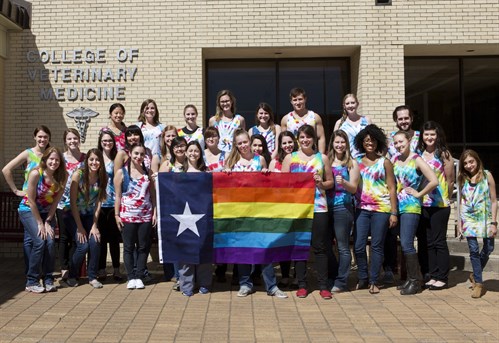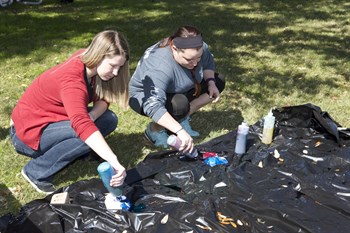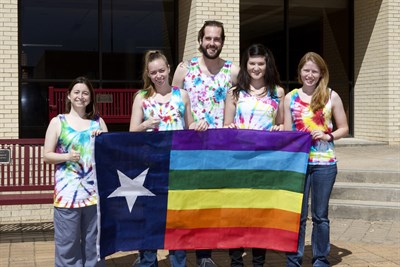Broad Spectrum–Celebrating Diversity in Veterinary Medicine
What started off as a plain t-shirt with a simple logo on the front and the words “stand up for diversity” on the back soon became a work of art. Students at the Texas A&M College of Veterinary Medicine & Biomedical Sciences (CVM) gathered at the annual “Show Your Colors” event to tie-dye shirts. But, the exercise was more than a social event. Instead, it highlighted how different people—and their colors—can come together and create something greater.

“The various colors come together and make something beautiful. Even though we’re all unique, we share many similarities,” said Angela Harrington, a fourth-year veterinary student.
The Show Your Colors event is hosted by Broad Spectrum and reflects the mission of the student-led organization. The aptly named student group has positioned itself as an umbrella organization, open to those of all sexual orientations and gender identities, including allies who may not consider themselves members of the Gay, Lesbian, Bisexual, Transgender (GLBT) community.
In addition to celebrating diversity, the group raises awareness about GLBT issues in the veterinary community. It not only provides a safe space, but also educates others about the important role of the GLBT community in veterinary medicine.
“We are here for everyone who has been different or has been bullied, or doesn’t feel like they fit in,” said Harrington, who is also the former president and 4vm representative of Broad Spectrum. “If you just want to come support and be our friend, that’s what we’re here for too.”
New Name, New Focus

Formerly the Lesbian and Gay Veterinary Medical Association or GLBT Vets, Broad Spectrum rebranded themselves in 2015 to better reflect their mission of inclusiveness and diversity. The group was particularly interested in expanding their reach to the ally population. “Most of our membership is from allies, so we do really count on that support,” said Harrington. “We also wanted to include faculty that wanted to be supportive of Broad Spectrum.”
As hoped, this rebranding attracted a number of new members. “We’ve always had difficulty getting people involved, especially from the ally population, but we were very encouraged by the result of the Show Your Colors event,” said Broad Spectrum President Austin Hardegree.
Harrington, who has been involved in the group since her first year of veterinary school, has seen this transformation first hand. “In my first year, there wasn’t a lot of involvement,” she said. “There has been more interest over the past two years. We have a lot of people saying ‘Hey, I want to get involved. How do I do this?’”
That supportive spirit is what has motivated many of the group’s members to become involved. Harrington initially joined the group in the hopes of finding friendship, and then became a representative of the group as a first year veterinary student. Similarly, former treasurer Sarah White joined the group to show her support. “I really joined the group to find solidarity,” she said. “I’ve talked to a lot of people that say, ‘Oh, that’s just for gay people.’ Well no, it’s not just for gay people. It’s for anybody that wants to take a stand and show solidarity with a minority on this campus.”
In many ways, Broad Spectrum is like other student groups. Its members attend field trips, socials, and educational events. In particular, the group is actively involved with Chimp Haven, the national chimpanzee sanctuary. They take field trips to Chimp Haven and support regular donation drives.
Being More Inclusive
One goal at the forefront of Broad Spectrum is to raise awareness about the importance of GLBT issues in veterinary medicine. Although these subjects seem unrelated, Hardegree points out that 78.5 percent of members of the GLBT community are pet owners. Additionally, they are likely to spend more money on their pets than their straight counterparts—as much as $300 to $432 on pet products per year.
Hardegree, who is also the president of the national Broad Spectrum Veterinary Student Association Board, has been actively involved in getting this message out. In 2015, he began working to refocus the mission of Broad Spectrum on raising awareness within the veterinary community at that year’s American Association of Veterinary Medical Colleges conference.
Broad Spectrum’s other officers agree that there are certainly financial reasons for being more inclusive. “I can’t imagine that any person would make a decision to exclude gay, bi, or lesbian people from their practice, because it’s a poor financial decision, as well as not a very kind decision either,” White said.
Members of Broad Spectrum suggest that small gestures go far when it comes to making a veterinary practice GLBT friendly. White said, “Just doing small things, like putting a small rainbow flag in your doorway, help. Most people won’t realize that it’s even there, and the people who it does matter to will notice.”
There are numbers of other ways that veterinarians can be more inclusive. Harrington noted the importance of diverse veterinary staff. “Diversity is beyond just clients and veterinarians; diversity includes technicians, receptionists, and others. I think that’s an area that we all need to focus on.”
Additionally, Harrington suggested diversifying whom veterinarians mentor. “If veterinarians have opportunities to mentor people who are minorities or part of the LGBT community, it would be great to reach out to those students because it can be difficult to be that student.”
The Future of Diversity

Students, faculty, and staff can take the lessons learned from Broad Spectrum beyond the CVM. Diversity can be implemented everywhere. In particular, Broad Spectrum stresses the importance of emphasizing diversity at all levels of the veterinary practice—something students can take with them after graduation.
“For veterinarians who plan on going into private practice, I think these things we learn about diversity are important because the more experiences you have with different people, the more you learn about the world, and to me that is the most important thing,” Hardegree said.
Putting diversity into practice after veterinary school is not just something the officers in Broad Spectrum say, it’s something they plan to do. Many of the members of Broad Spectrum plan on continuing their work on GLBT issues in veterinary medicine after they graduate.
White imagined how she will implement diversity in her future career. “Maybe I can make the staff that are already there aware of how important it is, and provide a safe place because the GLBT employee population is so important to foster,” she said. “The last thing I want is to have someone who wants to go to veterinary school be turned away because they don’t fit in, or discourage themselves from pursuing veterinary medicine because they think that the field is too closed minded.”
Hardegree said he hopes for a career in veterinary education and sees himself being involved in organizations similar to Broad Spectrum in the future. Likewise, Harrington also said she plans on continuing her work in GLBT issues and diversity.
In reflecting on how far the field has come, Harrington looks to the future with hope. “Diversity is not something that people were talking about 20 or 30 years ago,” she said. “When my mother went to veterinary school, it was predominately male. There’s been a huge shift.”
By working toward increased inclusiveness, members of Broad Spectrum hope to continue the shift toward a more diverse community at the CVM and beyond.


